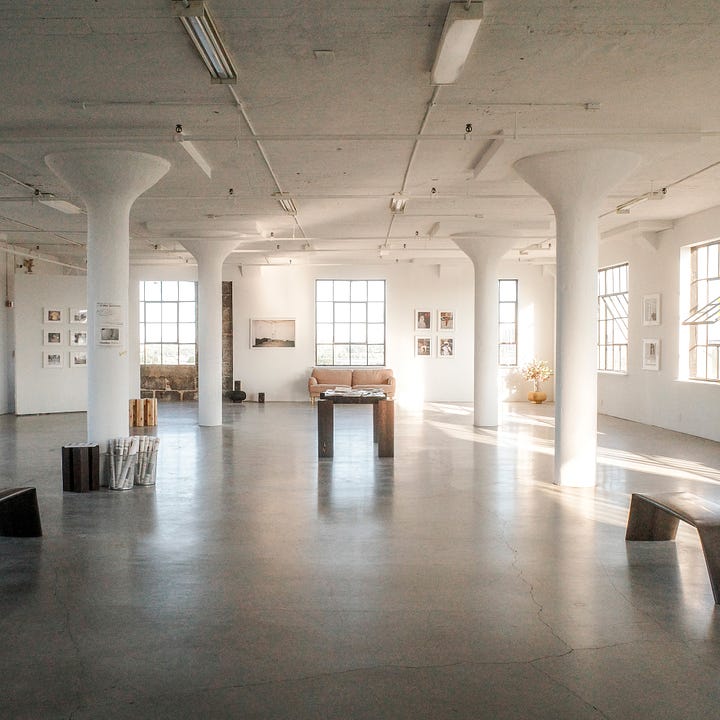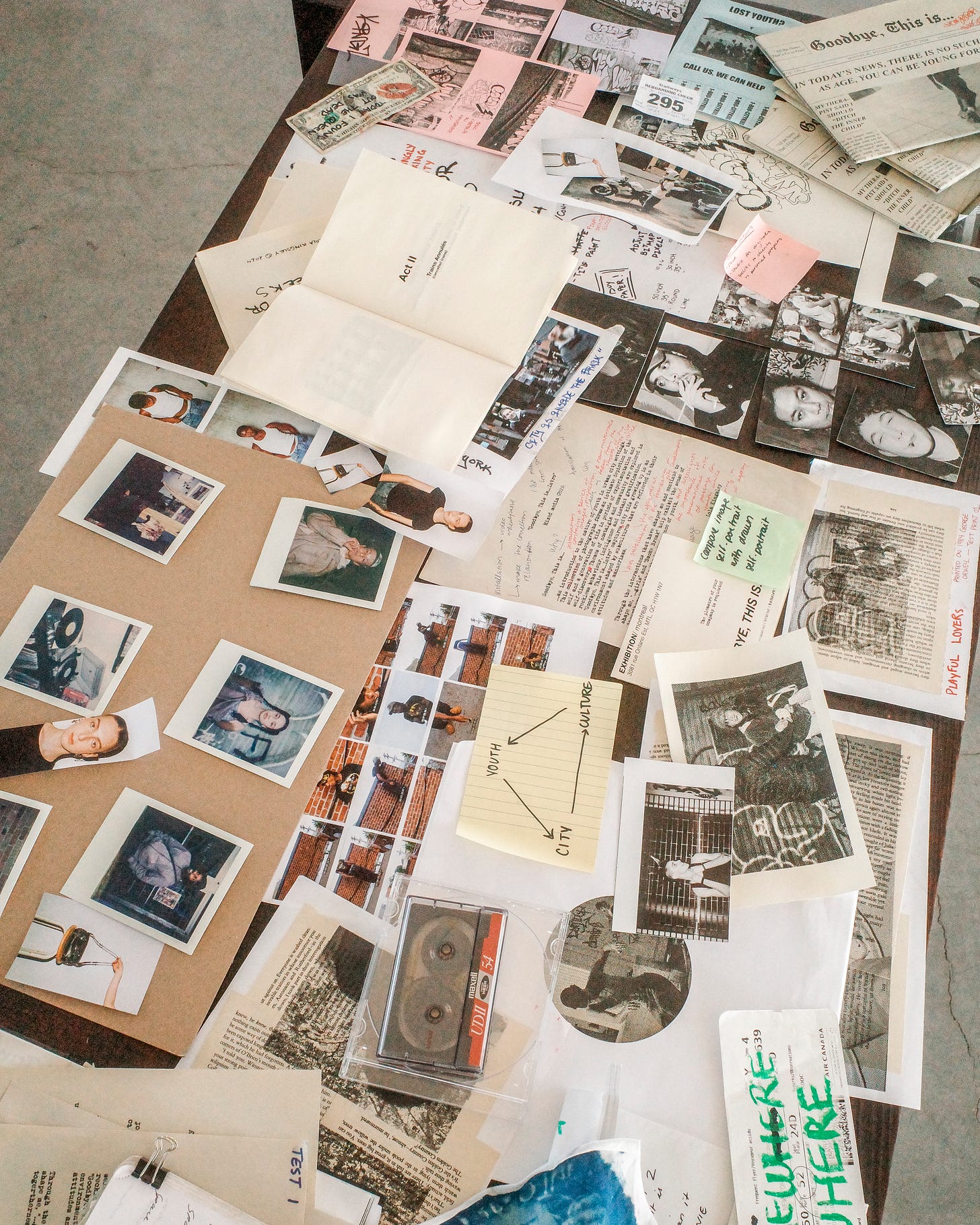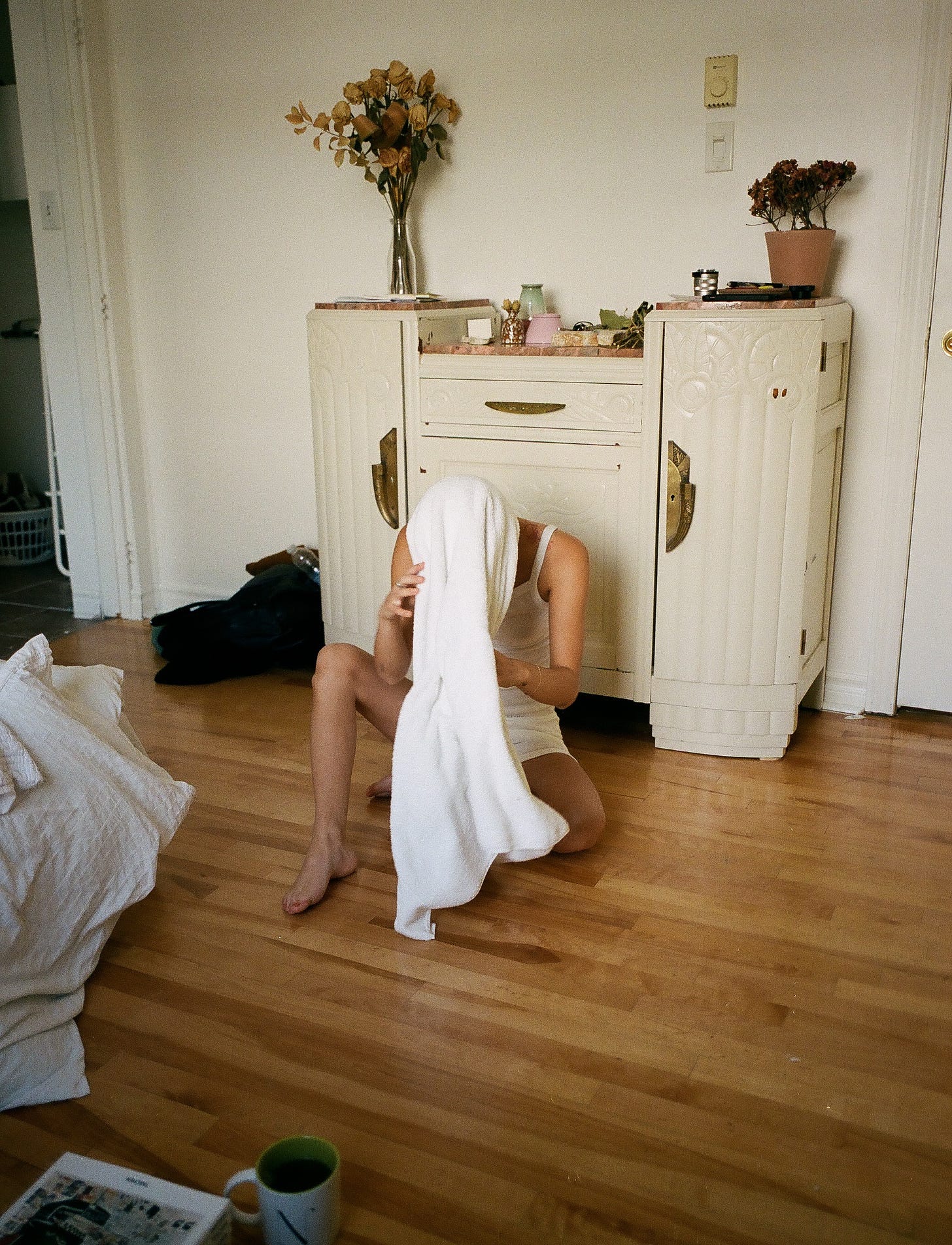The experience of Lola Kingsley’s first solo show, Goodbye, This is… begins six stories below the exhibition space, in the freight elevator. We’re not allowed to operate it ourselves, so the producing team has hired a doorman to bring the hoards of SSENSE-clad 20 somethings going to Lola’s show up and down all night. It feels like a scene out of a movie. The irony is not lost on me that, despite heading up to an exhibition celebrating youth, I’ve never felt more grown up.
As we step off the elevator, we are immediately met with the sheer beauty of the space (Studio Giovanelli): six equidistant columns frame the room while massive gridded windows on three sides open up to a view of each corner of the city. I regret to inform everybody that I got there after dark and therefore missed the opportunity for a final summer sunset in the space, but it looked great on Instagram. Lola’s photographs adorned the white walls while beautiful, minimally curated flower arrangements by Studio By Rose and organic industrial furniture by David Raymond tastefully filled the center.


Curated by the artist herself and creative producer Sarah Mercho, the works chosen for the exhibition “encapsulate a visual diary documenting the artist’s reflections from recent years, exploring the romanticized concept of ‘coming of age’ and the fleeting nature of youth”. The defining ages of youth are 13-24. Having recently turned 25, Goodbye, This is… is about Lola reflecting on the years behind her.
Lola explains to me that the nature of youth as a subject has followed her for a long time. Goodbye, This is… is a sentence that never ends because, although technically the years that you’re considered youth will pass, you can stay youthful forever. You’re closing a chapter of your life while opening the next, and they may speak to each other. Youth is a universal experience that we all struggle to put into words. It’s a feeling, a community, and aging doesn’t mean you’re ready to let it go, you can continue experiencing it.
Each photograph taken by Lola during this period of her life offers an authentic glimpse into the privacy of another. The mundanity of everyday life is shown beautifully in Emilie in her Room, in which a friend of Lola’s sits on the floor of her bedroom, towel drying her hair. “This photo is really about documenting the things you do everyday and showing why you would want to photograph them. I caught up with Emilie in the morning where she was most comfortable, doing what she normally does. It’s really a snapshot of that moment in her life.” Lola adds that, living in a house with roommates, having to do your morning routine in your room so as not to disturb others, feels quintessential to the experience of post-adolescence.
Another photograph that captures Lola’s signature documentary style is Breakfast Diner, in which Lola’s point-of-view positions her as the subject despite being out of the frame. When I bring this up to her, she smiles. “It’s really funny that you say that, because there’s a to-do list on the table among the plates of food. I was in New York with some friends and we were having breakfast, trying to figure out what to do with our day ahead. I had thought of editing out the list but people told me to keep it. It’s true that it makes it more authentic to the moment.”
The works bring viewers to the streets of Montreal, Paris, New York, and beyond to experience nostalgia for the lives we've never lived and the people we’ve never met; the chances that slip through our fingers like running water. “It reveals the essence of a transformative period marked by constant change and uncertainty - symbolizing one’s farewell of innocence and the onset of early adulthood.” This is perhaps most obvious not in the photos on the walls but in the centrepiece of the exhibition: an immense collage of notebooks, polaroids, scrap paper, zines, newspaper clippings and post-its piled atop a bespoke wooden table made by David Raymond. Which is, at the time of my writing this, still missing from my dining room.

Looking through the piles of memories (with my eyes, since there were signs everywhere asking viewers not to touch the pieces), the one that struck me most was a leaflet called Paris: A Short Guide on Being A Nomad for Three Weeks. When I mention the booklet to Lola, she laughs. “That trip was so traumatizing! It was really just catastrophe after catastrophe from the moment I got there to the moment I got home. My camera broke so I barely got any pictures out of the trip either, so when I was finally back in Montreal I decided I just needed to write about what had just happened. I was reading a lot of Fran Lebovitz at the time, so the guide is self-deprecating with a touch of humor. I think it was the most positive thing I could do about the whole experience.”
Co-curator Sarah Mercho describes the table as the trunk of the tree. "Once you look up at the walls, you realize that the photographs are actually its leaves. Everything ties in together." The research items on the table are the concepts and framework for the photographs. A catalyst. She adds that, if you look really closely at each piece on the table, you could connect it to the photos on the walls. Sarah herself is featured on the table, in a polaroid in which she is wearing a t-shirt with one of Lola’s prints on it. This photo was taken the day the two met.

When asked about the experience of working together, both girls are armed with praise for the other. "One of the aspects I value most in my work is the opportunity to support artists in achieving their goals with prosper. My collaboration with Lola was particularly rewarding. She not only placed her trust in me, but also in herself", Sarah says.
Oftentimes, popular depictions of youth culture (created by adults) highlight feelings of self-doubt and lack of direction, tucked obviously amidst the hedonism and bad decisions. Trusting yourself in your early twenties therefore seems foreign to me. When I ask Lola where she gets her [well deserved] confidence, she laughs that it comes from, “therapy, and a lot of introspection.”
“When you don’t know yourself, you’re automatically in a period of experimentation and self-discovery, so it’s really easy to do and try everything. You really have to tap into that. Let things come your way and let your opinions change.”
Lola Kingsley (b.1999) is a visual artist from Montreal. Using analog photography as her primary means of expression, the artist operates with a philosophy of consistent minimalism to reveal the essence of her subjects in a manner that feels transparent and authentic. Kingsley incorporates installations to enhance and complement the visual narrative for the audience's sensorial experience, inviting viewers into a personal dialogue with her subjects.
Community Service is a biweekly newsletter featuring a curated selection of art and design events in Montreal. If you have an art or design-related event you would like to include in future editions of the newsletter, you can send us a DM or email communityservmag@gmail.com






